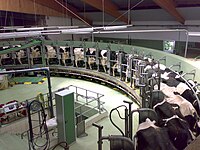
Photo from wikipedia
ABSTRACT Hydrogenotrophic methanogens typically require strictly anaerobic culturing conditions in glass tubes with overpressures of H2 and CO2 that are both time-consuming and costly. To increase the throughput for screening… Click to show full abstract
ABSTRACT Hydrogenotrophic methanogens typically require strictly anaerobic culturing conditions in glass tubes with overpressures of H2 and CO2 that are both time-consuming and costly. To increase the throughput for screening chemical compound libraries, 96-well microtiter plate methods for the growth of a marine (environmental) methanogen Methanococcus maripaludis strain S2 and the rumen methanogen Methanobrevibacter species AbM4 were developed. A number of key parameters (inoculum size, reducing agents for medium preparation, assay duration, inhibitor solvents, and culture volume) were optimized to achieve robust and reproducible growth in a high-throughput microtiter plate format. The method was validated using published methanogen inhibitors and statistically assessed for sensitivity and reproducibility. The Sigma-Aldrich LOPAC library containing 1,280 pharmacologically active compounds and an in-house natural product library (120 compounds) were screened against M. maripaludis as a proof of utility. This screen identified a number of bioactive compounds, and MIC values were confirmed for some of them against M. maripaludis and M. AbM4. The developed method provides a significant increase in throughput for screening compound libraries and can now be used to screen larger compound libraries to discover novel methanogen-specific inhibitors for the mitigation of ruminant methane emissions. IMPORTANCE Methane emissions from ruminants are a significant contributor to global greenhouse gas emissions, and new technologies are required to control emissions in the agriculture technology (agritech) sector. The discovery of small-molecule inhibitors of methanogens using high-throughput phenotypic (growth) screening against compound libraries (synthetic and natural products) is an attractive avenue. However, phenotypic inhibitor screening is currently hindered by our inability to grow methanogens in a high-throughput format. We have developed, optimized, and validated a high-throughput 96-well microtiter plate assay for growing environmental and rumen methanogens. Using this platform, we identified several new inhibitors of methanogen growth, demonstrating the utility of this approach to fast track the development of methanogen-specific inhibitors for controlling ruminant methane emissions.
Journal Title: Applied and Environmental Microbiology
Year Published: 2017
Link to full text (if available)
Share on Social Media: Sign Up to like & get
recommendations!